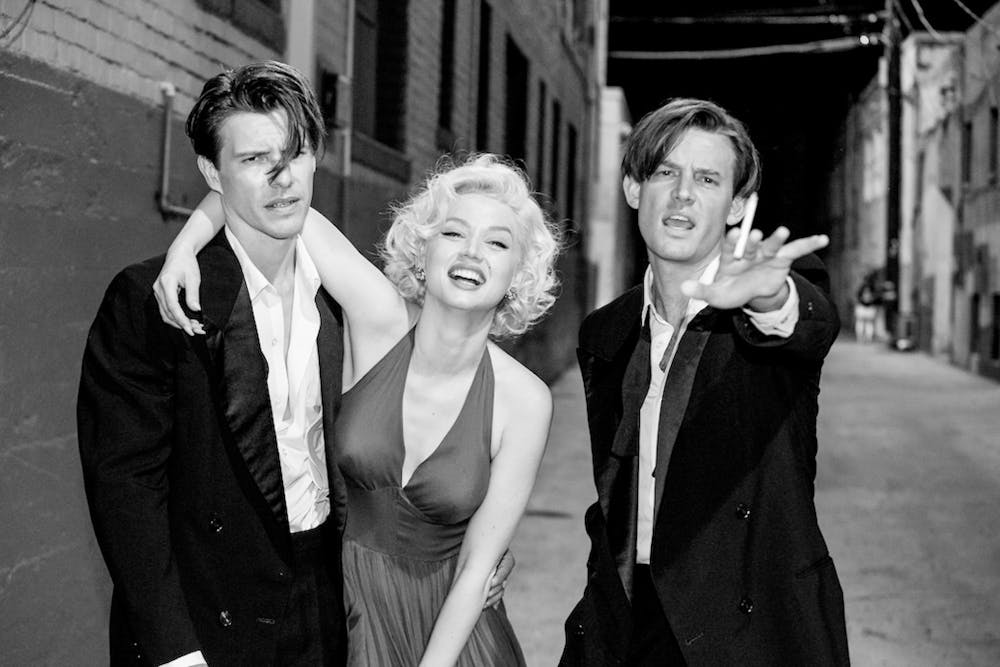When it was announced that “Blonde,” starring Ana de Armas as Hollywood icon Marilyn Monroe, would receive an NC-17 rating, there was some confusion among the cast and general public. De Armas claimed that the rating was unwarranted, and people were left wondering how a film about the American star received such a scandalous rating. But “Blonde” is anything but glamorous in both its themes and presentation. The contents of this almost three-hour film warrant the rating and feel unnecessarily provocative. Depictions of Monroe’s experience with abuse and addiction are not handled with care or subtlety, but rather with a near-fetishism that spins a complicated historical figure into a one-note vessel for excessive trauma.
To be clear, “Blonde” is not intended to be based on the real life of Marilyn Monroe; it’s based on a novel by Joyce Carol Oates that is marketed as a work of fiction, not a biography. Even if the film is able to dodge historiographical scrutiny, it is still subject to ridicule on the basis of its strange stylistic choices. In a seemingly benign but actually quite annoying aesthetic decision, the film constantly switches between scenes shot in color and scenes shot in black and white with no rhyme or reason. This choice follows a trend that plagues the entire film: Stylistic choices are made not for the good of the narrative but solely because they can be done.
There isn’t much of a narrative to this film in the first place. It meanders through Monroe’s life with little direction, jumping between short vignettes only tangentially related to one another. The film never looks far beyond the periphery of Monroe’s story, evoking confusion in the viewer rather than an intimate understanding of her life. Because it focuses so heavily on Monroe’s subjective experiences, the film ultimately lacks broader context to characterize her life. “Blonde” presupposes a knowledge of the star that most people just don’t have. If you have never researched Monroe or just vaguely know about her fame, very little of the story will make sense. In the blink of an eye, she goes from an abused child to the biggest star in the world with very little explanation in between.
Once she is at the peak of her stardom, Monroe quickly learns that fame is not everything it is cut out to be. She feels trapped and unable to live a real life, no matter how desperately she tries. She finds herself liminally stuck between two personas: Marilyn Monroe, the glamorous global star, and Norma Jeane, the woman who desires family and happiness. The pressures of being Marilyn Monroe mean that her inner Norma Jeane is suppressed, which causes the star to spiral into mental breakdowns and drug addiction. This aspect of the film is complex and layered on paper, but because of the movie’s sensationalization, any intrigue is completely washed out. The low points of Monroe’s downward spirals are demonstrated by gratuitously graphic and exploitative scenes. From abortions shown from the perspective of a CGI fetus to forced oral sex with President John F. Kennedy, “Blonde” cares more about shock value than being sympathetic to Marilyn Monroe or thoughtful toward her memory.
In the end, due to its reluctance to explore any other characters, “Blonde” rests entirely on Ana de Armas’s shoulders. If de Armas wasn’t playing Monroe, this performance would be fine, but because she is playing such a unique and revered figure, her performance verges on the uncanny valley and feels off for the entirety of the film. She almost looks like Marilyn Monroe and almost sounds like her, too, but the difference is just enough that viewers cannot help but notice it with the turn of each new scene. Oftentimes, it feels like she’s trying to impersonate Monroe, not act like her.
Everything in “Blonde” feels strange, completely unnecessary and, all too often, ethically wrong. Writer and director Andrew Dominik should be allowed a degree of creative license, but “Blonde” is an example of taking that creative license too far. Events that never happened in real life — including Monroe’s involvement in a throuple, multiple abortions and exclusively calling every man she has a relationship with “daddy” — do nothing to make the main character interesting, but do everything to disturb the audience, and not in a good way. “Blonde” is not the feminist telling of Marilyn Monroe’s life it so desperately wants to be — it’s overly pretentious trauma porn. The tragedy of Monroe’s life is used not for sympathy but rather for exploitation, and the film does nothing to celebrate the legacy of one of Hollywood’s greatest legends.

Finn Kirkpatrick was the senior editor of multimedia of the Brown Daily Herald's 134th editorial board. He is a junior from Los Angeles, California studying Comparative Literature and East Asian Studies. He was previously an arts and culture editor and has a passion for Tetris and Mario Kart.





